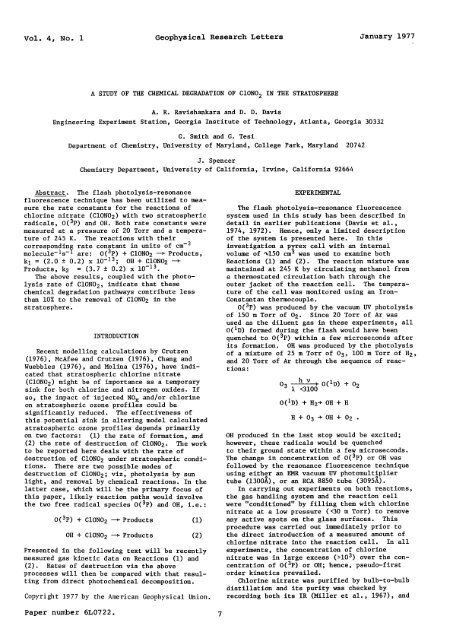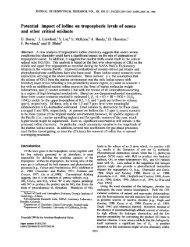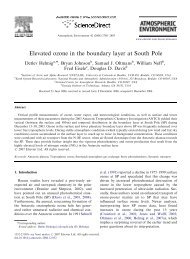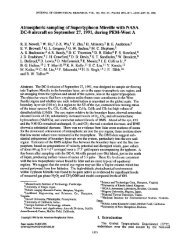A Study of the Chemical Degradation of ClONO2 in the ...
A Study of the Chemical Degradation of ClONO2 in the ...
A Study of the Chemical Degradation of ClONO2 in the ...
Create successful ePaper yourself
Turn your PDF publications into a flip-book with our unique Google optimized e-Paper software.
Vol. 4, No. 1 Geophysical Research Letters January 1977<br />
A STUDY OF THE CHEMICAL DEGRADATION OF ClONO 2 IN THE STRATOSPHERE<br />
A. R. Ravishankara and D. D. Davis<br />
Eng<strong>in</strong>eer<strong>in</strong>g Experiment Station, Georgia Institute <strong>of</strong> Technology, Atlanta, Georgia 30332<br />
G. Smith and G. Tesi<br />
Department <strong>of</strong> Chemistry, University <strong>of</strong> Maryland, College Park, Maryland 20742<br />
J. Spencer<br />
Chemistry Department, University <strong>of</strong> California, Irv<strong>in</strong>e, California 92664<br />
Abstract. The flash photolysis-resonance<br />
fluorescence technique has been utilized to measure<br />
<strong>the</strong> rate constants for <strong>the</strong> reactions <strong>of</strong><br />
chlor<strong>in</strong>e nitrate (ClONO 2) with two stratospheric<br />
radicals, O(3p) and OH. Both rate constants were<br />
measured at a pressure <strong>of</strong> 20 Torr and a temperature<br />
<strong>of</strong> 245 K. The reactions with <strong>the</strong>ir<br />
correspond<strong>in</strong>g rate constant <strong>in</strong> units <strong>of</strong> cm -3<br />
molecule-Is -1 are: O(3p) + ClONO 2 --Products,<br />
k! = (2.0 ñ 0.2) x 10-13; OH + ClON02 ---<br />
Products, k 2 = (3.7 ñ 0.2) x 10 -13 .<br />
The above results, coupled with <strong>the</strong> photo-<br />
lysis rate <strong>of</strong> ClON02, <strong>in</strong>dicate that <strong>the</strong>se<br />
chemical degradation pathways contribute less<br />
than 10% to <strong>the</strong> removal <strong>of</strong> ClON02 <strong>in</strong> <strong>the</strong><br />
stratosphere.<br />
INTRODUCTION<br />
Recent modell<strong>in</strong>g calculations by Crutzen<br />
(1976), McAfee and Crutzen (1976), Chang and<br />
Wuebbles (1976), and Mol<strong>in</strong>a (1976), have <strong>in</strong>dicated<br />
that stratospheric chlor<strong>in</strong>e nitrate<br />
(ClONO 2) might be <strong>of</strong> importance as a temporary<br />
s<strong>in</strong>k for both chlor<strong>in</strong>e and nitrogen oxides. If<br />
so, <strong>the</strong> impact <strong>of</strong> <strong>in</strong>jected NO x and/or chlor<strong>in</strong>e<br />
on stratospheric ozone pr<strong>of</strong>iles could be<br />
significantly reduced. The effectiveness <strong>of</strong><br />
this potential s<strong>in</strong>k <strong>in</strong> alter<strong>in</strong>g model calculated<br />
stratospheric ozone pr<strong>of</strong>iles depends primarily<br />
on two factors: (1) <strong>the</strong> rate <strong>of</strong> formation, and<br />
(2) <strong>the</strong> rate <strong>of</strong> destruction <strong>of</strong> ClON02. The work<br />
to be reported here deals with <strong>the</strong> rate <strong>of</strong><br />
destruction <strong>of</strong> ClONO 2 under stratospheric conditions.<br />
There are two possible modes <strong>of</strong><br />
destruction <strong>of</strong> ClON02; viz, photolysis by sun<br />
light, and removal by chemical reactions. In <strong>the</strong><br />
latter case, which will be <strong>the</strong> primary focus <strong>of</strong><br />
this paper, likely reaction paths would <strong>in</strong>volve<br />
<strong>the</strong> two free radical species O(3p) and OH, i.e.:<br />
0(3P) + C10N02 __+ Products (1)<br />
OH + ClONO 2 --+Products (2)<br />
Presented <strong>in</strong> <strong>the</strong> follow<strong>in</strong>g text will be recently<br />
measured gas k<strong>in</strong>etic data on Reactions (1) and<br />
(2). Rates <strong>of</strong> destruction via <strong>the</strong> above<br />
processes will <strong>the</strong>n be compared with that resul-<br />
t<strong>in</strong>g from direct photochemical decomposition.<br />
Copyright 1977 by <strong>the</strong> American Geophysical Union.<br />
Paper number 6L0722. 7<br />
EXPERIMENTAL<br />
The flash photolysis-resonance fluorescence<br />
system used <strong>in</strong> this study has been described <strong>in</strong><br />
detail <strong>in</strong> earlier publications (Davis et al.,<br />
1974, 1972). Hence, only a limited description<br />
<strong>of</strong> <strong>the</strong> system is presented here. In this<br />
<strong>in</strong>vestigation a pyrex cell with an <strong>in</strong>ternal<br />
volume <strong>of</strong> 150 cm 3 was used to exam<strong>in</strong>e both<br />
Reactions (1) and (2). The reaction mixture was<br />
ma<strong>in</strong>ta<strong>in</strong>ed at 245 K by circulat<strong>in</strong>g methanol from<br />
a <strong>the</strong>rmostated circulation bath through <strong>the</strong><br />
outer jacket <strong>of</strong> <strong>the</strong> reaction cell. The temperature<br />
<strong>of</strong> <strong>the</strong> cell was monitored us<strong>in</strong>g an Iron-<br />
Constantan <strong>the</strong>rmocouple.<br />
O(3P) was produced by <strong>the</strong> vacuum UV photolysis<br />
<strong>of</strong> 150 m Torr <strong>of</strong> 02 . S<strong>in</strong>ce 20 Torr <strong>of</strong> Ar was<br />
used as <strong>the</strong> diluent gas <strong>in</strong> <strong>the</strong>se experiments, all<br />
O(1D) formed dur<strong>in</strong>g <strong>the</strong> flash would have been<br />
quenched to O(3P) with<strong>in</strong> a few microseconds after<br />
its formation. OH was produced by <strong>the</strong> photolysis<br />
<strong>of</strong> a mixture <strong>of</strong> 25 m Torr <strong>of</strong> 03, 100 m Torr <strong>of</strong> H2,<br />
and 20 Torr <strong>of</strong> Ar through <strong>the</strong> sequence <strong>of</strong> reac-<br />
tions'<br />
03 % h 0(1D ) + 02<br />
O(1D) + H2+ OH + H<br />
H + 03 -+ OH + 02 ß<br />
OH produced <strong>in</strong> <strong>the</strong> last stop would be excited;<br />
however, <strong>the</strong>se radicals would be quenched<br />
to <strong>the</strong>ir ground state with<strong>in</strong> a few microseconds.<br />
The change <strong>in</strong> concentration <strong>of</strong> O(3P) or OH was<br />
followed by <strong>the</strong> resonance fluorescence technique<br />
us<strong>in</strong>g ei<strong>the</strong>r an EIR vacuum UV photomultiplier<br />
tube (1300), or an RCA 8850 tube (3095).<br />
In carry<strong>in</strong>g out experiments on both reactions,<br />
<strong>the</strong> gas handl<strong>in</strong>g system and <strong>the</strong> reaction cell<br />
were "conditioned" by fill<strong>in</strong>g <strong>the</strong>m with chlor<strong>in</strong>e<br />
nitrate at a low pressure (103 ) over <strong>the</strong> concentration<br />
<strong>of</strong> O(3p) or OH; hence, pseudo-first<br />
order k<strong>in</strong>etics prevailed.<br />
Chlor<strong>in</strong>e nitrate was purified by bulb-to-bulb<br />
distillation and its purity was checked by<br />
record<strong>in</strong>g both its IR (Miller et al., 1967), and
8 Ravishankara et al.: <strong>Chemical</strong> <strong>Degradation</strong><br />
3OO i<br />
I00<br />
00(p) + CIONO,<br />
i I I<br />
0 5 I0 15<br />
rntorr <strong>of</strong> ClONO 2<br />
FIGURE 1<br />
A plot <strong>of</strong> <strong>the</strong> pseudo-first order rate constant for<br />
<strong>the</strong> decay <strong>of</strong> OH [O], or O(3p) [O] as a function <strong>of</strong><br />
ClONO<br />
!<br />
ments <strong>of</strong> <strong>the</strong> rate constant kl, and f<strong>in</strong>d<strong>in</strong>g<br />
steadily <strong>in</strong>creas<strong>in</strong>g k 1 values with an <strong>in</strong>crease<br />
<strong>in</strong> <strong>the</strong> residence time. However, at 245 K <strong>the</strong>re<br />
was no evidence for <strong>the</strong> decomposition <strong>of</strong> ClONO 2.<br />
For this reason, both reactions were studied at<br />
<strong>the</strong> reduced temperature <strong>of</strong> 245 K.<br />
Ozone was prepared by pass<strong>in</strong>g 02 through an<br />
ozonator. Before use, 03 was purified by<br />
cont<strong>in</strong>uously pump<strong>in</strong>g while at 195 K; its purity<br />
was checked by UV absorption spectroscopy. UHP<br />
grade Ma<strong>the</strong>son H 2 and 02, and UHP gold label Ar<br />
were used without fur<strong>the</strong>r purification.<br />
RESULTS AND DISCUSSION<br />
The rate constants for both Reactions (1) and<br />
(2) were measured at 245 K simulat<strong>in</strong>g stratospheric<br />
temperatures. The pseudo-first order<br />
rate constants, k' 1 and k2, ' for <strong>the</strong> disappearance<br />
<strong>of</strong> O(3p) and OH are shown as a function <strong>of</strong> <strong>the</strong><br />
ClON02 pressure <strong>in</strong> Figure 1. L<strong>in</strong>ear least square<br />
analyses <strong>of</strong> <strong>the</strong> data were carried out to obta<strong>in</strong><br />
<strong>the</strong> bimolecular rate constants, kbi. At 245 K,<br />
<strong>the</strong> kbi values are<br />
2 pressure at 245 K. The error bars <strong>in</strong> <strong>the</strong>se -13<br />
plots show <strong>the</strong> total uncerta<strong>in</strong>ty observed <strong>in</strong> three kl = (2.0 +.2) x 10<br />
to four <strong>in</strong>dependent measurements <strong>of</strong> <strong>the</strong> first order and<br />
-1 -1<br />
cc molecule sec<br />
rate constant at a given ClONO 2 pressure. k2 = (3.7 +.2) x 10 -13 cc molecule-lsec -1.<br />
UV spectrum. On <strong>the</strong> basis <strong>of</strong> <strong>the</strong>se analyses,<br />
toge<strong>the</strong>r with calculations <strong>of</strong> <strong>the</strong> O(3P) loss due For Reactions (1) and (2), <strong>the</strong> quoted errors are<br />
to <strong>the</strong> reaction, O(3P) + NO 2 --+ NO + 02 (Davis two standard deviations.<br />
et al., 1973), <strong>the</strong> NO 2 impurity level was placed<br />
at less than .5%. It should be noted, however,<br />
In <strong>the</strong> <strong>in</strong>vestigations <strong>of</strong> Reactions (1) and (2)<br />
<strong>the</strong> concentration <strong>of</strong> ClONO 2 (>1014 molecule cm -3)<br />
that at 298 K <strong>the</strong>re was evidence <strong>in</strong>dicat<strong>in</strong>g that was typically a thousand times greater than that<br />
ClONO 2 decomposed <strong>in</strong> <strong>the</strong> glass reaction cell when <strong>of</strong> ei<strong>the</strong>r O(3P) (
een negligible. Support<strong>in</strong>g evidence <strong>of</strong> this<br />
po<strong>in</strong>t <strong>of</strong> view was provided by carry<strong>in</strong>g out sever-<br />
al flash energy variation experiments, typically<br />
a factor <strong>of</strong> four, and f<strong>in</strong>d<strong>in</strong>g that <strong>the</strong> pseudo-<br />
first order rate constants kl and k were<br />
<strong>in</strong>dependent <strong>of</strong> <strong>the</strong> flash <strong>in</strong>tensity. S<strong>in</strong>ce any<br />
secondary reaction would necessarily <strong>in</strong>volve<br />
ei<strong>the</strong>r <strong>the</strong> phot<strong>of</strong>ragments <strong>of</strong> C1ONO 2 or products<br />
<strong>of</strong> Reactions (1) and (2), <strong>the</strong> decay rate <strong>of</strong><br />
O(3p) or OH would be proportional to <strong>the</strong> square<br />
<strong>of</strong> <strong>the</strong> flash energy. As noted above, no such<br />
observation was recorded.<br />
Table I lists <strong>the</strong> relative chemical degradation<br />
rates (R i and R2) as a function <strong>of</strong> altitude<br />
result<strong>in</strong>g from Reactions (1) and (2). The<br />
destruction <strong>of</strong> C1ONO 2 through its reaction with<br />
C1(2p3/2) has not been <strong>in</strong>cluded <strong>in</strong> <strong>the</strong> quoted<br />
total chemical degradation rate because: (1)<br />
Ravishankara et al.: <strong>Chemical</strong> <strong>Degradation</strong> 9<br />
<strong>the</strong> rate constant for <strong>the</strong> reaction <strong>of</strong> C1(2P3s/2)<br />
with C1ONO 2 is only 1 x 10-1cm molecule-! -!<br />
accord<strong>in</strong>g to prelim<strong>in</strong>ary results obta<strong>in</strong>ed <strong>in</strong><br />
ourslaboratory, and (2) <strong>the</strong> concentration <strong>of</strong><br />
Ci(P3/2) at mid-stratospheric altitudes is very<br />
much lower than that <strong>of</strong> ei<strong>the</strong>r OH or O(P).<br />
Along with <strong>the</strong> chemical degradation rates, we<br />
have listed <strong>the</strong> photochemical destruction rate<br />
(J), as well as <strong>the</strong> total degradation rate <strong>of</strong><br />
C1ONO 2 (R! + R 2 + J). As can be seen from <strong>the</strong><br />
Table, chemical processes (1) and (2) contribute<br />
less than 10% to <strong>the</strong> total rate <strong>of</strong> C1ONO 2<br />
destruction at altitudes less than 30 Km. S<strong>in</strong>ce<br />
th concentration <strong>of</strong> C1ONO 2 is calculated to be<br />
near its maximum around 25 Km and drops <strong>of</strong>f<br />
very significantly at higher altitudes, it must<br />
be concluded that <strong>the</strong> photochemical decomposition<br />
<strong>of</strong> C1ONO 2 <strong>in</strong> <strong>the</strong> stratosphere is by far<br />
<strong>the</strong> most important degradation path for this<br />
molecule. It is possible that <strong>the</strong> contribution<br />
<strong>of</strong> <strong>the</strong> chemical degradation rate to <strong>the</strong> total<br />
destruction <strong>of</strong> C1ONO 2 could be different from<br />
our calculations s<strong>in</strong>ce, (a) <strong>the</strong> concentration <strong>of</strong><br />
OH radicals <strong>in</strong> <strong>the</strong> stratosphere is still not well<br />
known, and (b) radicals o<strong>the</strong>r than OH, O(P), or<br />
C!(2p/2) could also degrade C1ONO2 to a signifi-<br />
cant degree. However, we do not expect our basic<br />
conclusion, that photolysis is <strong>the</strong> dom<strong>in</strong>ant mode,<br />
to change.<br />
Acknowledgements. D. D. Davis would like to<br />
acknowledge th f<strong>in</strong>ancial support <strong>of</strong> this work by<br />
<strong>the</strong> National Aeronautics and Space Adm<strong>in</strong>istration.<br />
G. Tesi was on sabbatical leave from <strong>the</strong> National<br />
Science Foundation dur<strong>in</strong>g this project.<br />
References<br />
Chang, J. and D. Wuebbles, "An Analysis <strong>of</strong><br />
Coupled <strong>Chemical</strong> K<strong>in</strong>etics and Transport Models<br />
<strong>of</strong> <strong>the</strong> Stratosphere", Intnl. Ozone Symposium,<br />
Dresden, E. Germany, August 1976.<br />
Crutzen, P.J., Review <strong>of</strong> Atmospheric Chlor<strong>in</strong>e<br />
Chemistry, Intnl. Ozone Symposium, Dresden,<br />
E. Germany, August 1976.<br />
Davis, D.D., R.E. Huie, J.T. Herron, M.J. Kurylo,<br />
and W. Braun, "Absolute Rate Constant for <strong>the</strong><br />
Reaction <strong>of</strong> Atomic Olygen with Ethylene Over<br />
<strong>the</strong> Temperature Range 232-500 K", J. Chem.<br />
Phys., 56, p.4868 (1972).<br />
Davis, D.D., J. Herron, and J. Huie, "Absolute<br />
Rate Constant for <strong>the</strong> Reaction O(3P) + NO 2<br />
--NO + 02 Over <strong>the</strong> Temperature Range 230-<br />
339 K", J. Chem. Phys., 58, p.530 (1973).<br />
Davis, D.D., S. Fischer, and R. Schiff, "Flash<br />
Photolysis Resonance Fluroescence K<strong>in</strong>etics<br />
<strong>Study</strong>: Temperature Dependence <strong>of</strong> <strong>the</strong> Reactions<br />
OH + CO--+ CO 2 + H, and OH + CH4--H20<br />
J. Chem. Phys., 61, p.2213 (1974).<br />
+ CH 3,<br />
Liu, S.C., T.M. Donahue, R. Cicerone, and W.L.<br />
Chameides, "Effects <strong>of</strong> Water Vapor on <strong>the</strong><br />
Destruction <strong>of</strong> Ozone <strong>in</strong> <strong>the</strong> Stratosphere Perturbed<br />
by C1 x or NOx Pollutants", J. Geophys.<br />
Res., 81, pp.3111-3118 (1976).<br />
McAfee, J. and P.J. Crutzen, Modell<strong>in</strong>g Stratospheric<br />
Photochemistry and K<strong>in</strong>etics, The 12th<br />
Informal Conference on Photochemistry, NBS,<br />
U.S.<br />
1976.<br />
Department <strong>of</strong> Commerce, June 28 - July 1,<br />
Miller, R.H., D.L. Bernitt, and I.C. Hisatsune,<br />
"Infrared Spectra <strong>of</strong> Isotopic Halogen Nitrates<br />
Spectrochimica Acta, 23A, p.223 (1967).<br />
Mol<strong>in</strong>a, M.J., Atmospheric Chemistry <strong>of</strong> Chlor<strong>of</strong>luorocarbons,<br />
The 12th Informal Conference<br />
on Photochemistry, NBS, U.S. Department <strong>of</strong><br />
Commerce, June 28 - July 1, 1976.<br />
(Received November 3, 1976;<br />
accepted November 18, 1976. )






